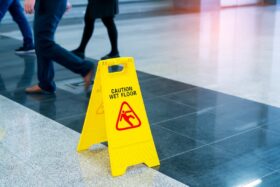What’s the Difference Between a Slip & Fall and a Trip & Fall Accident?

When somebody falls, they likely don’t think twice about whether they call it a slip or a trip. After all, both words indicate that somebody fell down. But while the words “slip” and “trip” are often used interchangeably, there actually is a difference between the two. And if you’ve been injured in a fall, those words can be important in describing your accident.
The key differences between a slip and fall and a trip and fall come down to what caused your accident and what types of injuries it caused. In a slip and fall, it means that the fall was caused by something slippery on the ground, such as a patch of ice, spilled water, or cleaning products on a recently cleaned floor. While slip and falls often involve liquids of some kind, they can occasionally involve solid objects, such as small beads or ball bearings that have fallen on the ground. In a trip and fall, it means the fall was caused by a person’s foot getting caught on something, such as a long power cord, the edge of a rug, or uneven pavement.
The cause of the fall affects the direction a person falls in. When a person slips, they tend to fall backwards. But when they trip, they tend to fall forward. This difference in direction, in turn, affects the types of injuries a fall can cause.
Slip Injuries vs. Trip Injuries
Since people fall backwards when they fall, slip and fall accidents are more likely to cause injuries to the spinal cord, neck, back, and hips. Head and brain injuries are also common in slip and fall cases. The actions and forces that occur during a slip can also cause ankle sprains.
Since people fall forwards when they trip, and often use their hands and arms to try and break the fall, this means trips tend to cause injuries to hands, arms, shoulders, and elbows. Knee injuries are also common since people often land on their knees when they trip.
Slips and trips can both cause injuries to the head, but those injuries typically occur in different parts of the head. The backwards motion of a fall means that head injuries in a slip and fall are more likely to occur to the back of the head. But since trips involve a forward motion, injuries tend to occur in the facial area and in the mouth.
Contact a Michigan Slip & Fall Accident Lawyer
If you’ve been injured in a slip or fall or a trip or fall, it’s important to have a lawyer on your side who has the experience to help you get the justice you deserve. At Scott Goodwin Law, you’ll be able to get help from a slip and fall lawyer who has helped many people who have been in your shoes. Contact us today to schedule a free consultation and find out how we can help you.






